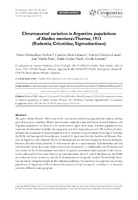Chromosomal variation in Argentine populations of Akodon montensis Thomas, 1913 (Rodentia, Cricetidae, Sigmodontinae)
Date
2016-02-02Author
Malleret, Matías Maximiliano
Labaroni, Carolina Alicia
García, Gabriela Verónica
Ferro, Juan Martín
Martí, Dardo Andrea
Lanzone, Cecilia
Metadata
Show full item recordAbstract
The genus Akodon Meyen, 1833 is one of the most species-rich among sigmodontine rodents and has great chromosome variability. Akodon montensis has a relatively broad distribution in South America, and Argentine populations are located in the southernmost region of its range. Brazilian populations have important chromosomal variability, but cytogenetic data from Argentina are scarce. We performed a chromosome characterization of natural populations of A. montensis using conventional staining, C-banding, Ag-NORs and base-specific fluorochromes. A total of 31 specimens from five localities of Misiones Province, in Argentina, were analyzed. The 2n=24 chromosomes was the most frequently observed karyotype. However, five individuals presented 25 chromosomes due to a supernumerary B-chromosome; and one individual had 2n=26 due to one B plus a trisomy for chromosome 11. Additionally, two XY females and two variants of the X chromosomes were found. C-positive centromeric bands occurred in all chromosomes; additional C-bands were observed in some autosomes, the X, Y and B chromosomes. Ag-NORs were observed in five autosomes, and the B chromosome was frequently marked. Fluorochrome banding was similar among karyotypes of the analyzed populations. Comparisons of cytogenetic data among populations of Argentina and Brazil showed the presence of high intraspecific variability in A. montensis and some differences among regions.
Collections
The following license files are associated with this item:




